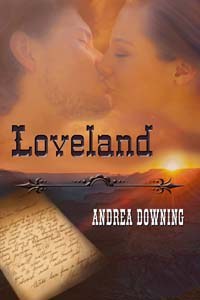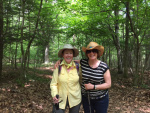Andrea Downing's Blog, page 6
March 18, 2016
A Sultry Childhood Journey . . . .
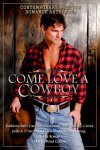 I’m happy to have here once more fellow author from Come Love a Cowboy Keta Diablo.
I’m happy to have here once more fellow author from Come Love a Cowboy Keta Diablo.
COME LOVE A COWBOY is now available at http://Come-Love-Cowboy-Kathleen-Ball-ebook/dp/B01D5876UK/
The dictionary says sultry means to be hot with passion or to be capable of exciting strong sexual desire. But sultry can also mean sweltering or torrid.
Have you ever heard a word that reminds you of a certain time and place, almost like a déjà vu? When I hear the word sultry it reminds of only one thing – To Kill A Mockingbird by Harper Lee. I know, it’s a silly analogy. Most of the time sultry should remind one of steamed heat or perhaps conjure an image of Marilyn Monroe standing over a street vent, her short skirt billowing about her.
Not me. When I hear the word sultry I’m taken on a journey back to my childhood, seventh grade to be exact. That year, my teacher placed a copy of To Kill A Mockingbird on my desk with a simple note, “Read this. I hope it opens many doors for you.”
At the time, I thought it a strange note, but then Miss Holmquist was rather strange. (Picture a short, stout woman with flabby upper arms that jiggled when she worked the chalkboard). Still, the woman piqued my interest with her odd message. How could books open doors? Why did I want to read about an old lawyer in a southern state I knew nothing about? And, what’s more, what kind of a man would name his children Jem and Scout?
I took the book home and several days passed before I opened it and read the first line, “When he was thirteen, my brother Jem got his arm badly broken at the elbow.” Hmm,
Ms. Harper Lee, whoever she is, has my attention now,” I said aloud. “Who is Jem and how did he break his arm?”
From that moment I was hooked – mesmerized by the story, in awe over the character names, Boo Radley, Aunt Avery, Dill, Atticus, and Calpurnia. I’m still in awe of the plot, the personalities, and the vivid neighborhood descriptions.
So why does the word “sultry” remind me of To Kill A Mockingbird? Because for the first time in my life I realized that by simply turning the pages, I could feel the sultry heat, taste the prejudice and agonize over the hatred between black and white.
“So what did you discover in this book?” Miss Holmquist asked two weeks later. I didn’t know where to begin. Should I tell her about the rollercoaster of emotions I went through while reading? Do I dare ask why the jury convicted Tom even though I prayed they wouldn’t? Or maybe I should tell her how brave Scout was when she diffused an explosive situation between Atticus and the bigots of the town with a simple, “Hey there, Mr. Ewell, how’s your boy, Henry doing?”
I didn’t ask her any of those things, but I did tell her about every sentiment I felt. Mostly I told her about the bitter taste in my mouth over a word called prejudice, and I told her I felt the hot, sultry sun of Maycomb County.
Some days, I wish I could go back to 7th grade and ask Miss Holmquist if she knew one day To Kill A Mockingbird would be one of the best-loved stories of all time, that it would earn many distinctions since its original publication in 1960. I’d ask her if she thought it would win the Pulitzer Prize one day and be translated into more than forty languages. And Miss Holmquist, do you think it will sell more than thirty million copies worldwide and will it be made into an enormously popular movie?
You know, I think Miss Holmquist would have said, “Yes, I do think Miss Lee’s novel will achieve all those things and more, but the most important thing, Keta, To Kill A Mockingbird will transport you to the sultry heat of the deep south and will take you to places you never dreamed existed.”
And I would say, “Thank you, Miss Holmquist.”
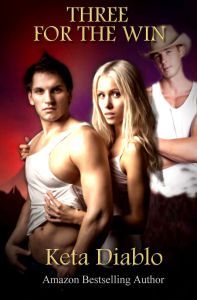 Keta Diablo writes contemporary and historical romance. Her most recent story, Three for the Win, appears in COME LOVE A COWBOY, an anthology of 8 contemporary western romance stories.
Keta Diablo writes contemporary and historical romance. Her most recent story, Three for the Win, appears in COME LOVE A COWBOY, an anthology of 8 contemporary western romance stories.
You can find her on the Web at the following places:
Keta’s Keep: http://ketaskeep.blogspot.com
Facebook page: https://www.facebook.com/KetaDiablo.Author
Pinterest: https://www.pinterest.com/ketadiablo/
Twitter: http://twitter.com/ketadiablo
And don’t forget you can read Keta’s story in Come Love a Cowboy along with seven other stories for just 99 cents at http://Come-Love-Cowboy-Kathleen-Ball-ebook/dp/B01D5876UK/


March 5, 2016
COMING SOON–to an eReader near you
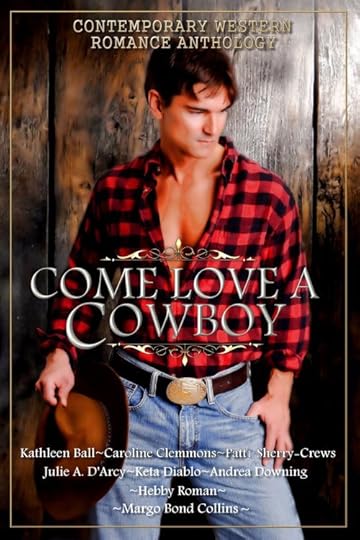 A few months ago, I was delighted to be asked to join seven other authors in an anthology of contemporary western romance. It was quite an honor, considering several of them are far better known than I, and have best sellers. At this time, the book, titled Come Love a Cowboy, is due out on or about March 15, and I’ll be having each of the authors visit for a one week slot to tell you about their individual stories. For now, however, I’m very pleased to have Keta Diablo, who was the primary organizer of the anthology, tell you a little bit more about the background to the book.
A few months ago, I was delighted to be asked to join seven other authors in an anthology of contemporary western romance. It was quite an honor, considering several of them are far better known than I, and have best sellers. At this time, the book, titled Come Love a Cowboy, is due out on or about March 15, and I’ll be having each of the authors visit for a one week slot to tell you about their individual stories. For now, however, I’m very pleased to have Keta Diablo, who was the primary organizer of the anthology, tell you a little bit more about the background to the book.
Keta is a bestselling Amazon author. Her historical romance and contemporary romance novels have won numerous awards, including a Bookie Nomination, Book of the Month Awards, Top Reviewer Awards, and Recommended Reader Awards.
 Keta:
Keta:
The authors of Come Love A Cowboy are so appreciative for the opportunity to share our stories with you. Some of the authors in CLAC have worked together before on anthologies, albeit historical western romance. It didn’t take long for us to discover that readers who love cowboys love ALL eras of cowboys. Thus, Come Love A Cowboy, an anthology of contemporary western romance stories, was born. We hope you enjoy reading our stories as much as we enjoyed writing them. Please remember, the best way to thank an author is to leave a review, in this case, on Amazon.
If you’d like to know more about Keta’s books, visit her Amazon page:
http://www.amazon.com/Keta-Diablo/e/B002BODURI/


January 30, 2016
Delbert’s Weir: Hooking into Tradition
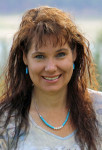 Fellow member of Women Writing the West, Carmen Peone has lived in Northeast Washington on the Colville Confederated Indian Reservation since 1988, gleaning knowledge from Joe, her tribal member husband, other family members and friends. She has worked with tribal elder, Marguerite Ensminger, for three years learning the Arrow Lakes-Sinixt- Language as well as various cultural traditions and legends. With a degree in psychology, the thought of writing never entered her mind until she married her husband and they moved to the reservation after college. She came to love the people and their heritage and wanted to create a legacy for her sons.
Fellow member of Women Writing the West, Carmen Peone has lived in Northeast Washington on the Colville Confederated Indian Reservation since 1988, gleaning knowledge from Joe, her tribal member husband, other family members and friends. She has worked with tribal elder, Marguerite Ensminger, for three years learning the Arrow Lakes-Sinixt- Language as well as various cultural traditions and legends. With a degree in psychology, the thought of writing never entered her mind until she married her husband and they moved to the reservation after college. She came to love the people and their heritage and wanted to create a legacy for her sons.
Carmen’s new release is entitled Delbert’s Weir. It is a young adult survival book that takes place in the mid-1800s and concerns Delbert Gardner, a teen boy, and his two friends in Northeast Washington Territory, who want a chance at learning traditional Native hunting and fishing methods from their American Indian friend, Pekam.
Carmen has very kindly consented to give away one ebook copy to someone who leaves a comment! Winner will be announced on or about Feb. 15
Three years ago, the Colville Confederated Tribes brought back traditional fishing in the form of a fence style weir as shown below.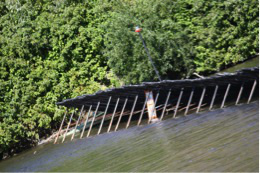 Traditional weirs were made of Cottonwood and Indian hemp rope or rope from the stalk of the cattail, or tule. Today the weir that stretches across the Okanogan River is made of aluminum for easy annual set up and tear down.
Traditional weirs were made of Cottonwood and Indian hemp rope or rope from the stalk of the cattail, or tule. Today the weir that stretches across the Okanogan River is made of aluminum for easy annual set up and tear down.
Before Grand Coulee Dam was built in 1942, salmon migrated roughly 700 miles from the Pacific Ocean, where the mouth of the Columbia River divides Washington and Oregon, to spawn up at the Kettle Falls located just below the Canadian Border. This was the site where the Arrow Lakes or Sinixt and many other tribes would fish off wooden scaffolds, harvesting the ones too weak to jump with fifty foot falls. They would then wind dry their bounty and store the fish in baskets in order to feed the people during harsh winter months.
In the smaller tributaries like the Okanogan River, Indigenous tribes would use fence style weirs of either wood or rock to catch salmon. Today, they use the same style of weir, but instead of wind drying the meat, it is vacuum sealed and frozen, then distributed to tribal members as needed. Every year thousands (in 2014 40,000) of salmon are trapped by the pictured weir. This has brought back traditional food to the Colville Tribal Members and their families by traditional means. In a way, lost honor is restored to the people.
The idea of using a weir in a boys survival book entered my mind during the time my husband was the director for the Colville Tribes Fish and Wildlife department. At that time, they were in the beginning stages of building the aluminum weir and weaving the ties of tradition once again through the hearts of the people. The tribe owns and operates two hatcheries that raise Chinook salmon.
Another traditional fish catching means was with a trap in the shape of a heart at the edge of a stream bank. The fish could enter through the top of the curves that form the heart, drop in, and not be able to find their way out. The same strategy is used for making bee catchers out of plastic pop bottles.
All photos the author’s own.
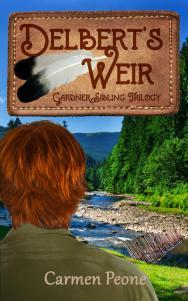
In a time when the west was still untamed, sixteen-year-old Delbert Gardner leads two friends into the backcountry for a three day adventure. Little did they know three days of hunting and fishing would turn into eight days of near starvation, injury and illness. When hope of returning home seems out of reach, Delbert recalls watching his Native American friends construct a fishing weir and sets out to build one himself. To him, it is the only way out.
Excerpt:
Delbert found three long sticks and handed them over to Jed and Ross who speared slabs of fresh meat on the ends and roasted them over the fire. The aroma of sizzling meat wafted in the air and wedged in Delbert’s nose. He joked and laughed with his friends as they waited. Hungry. Anxious.
The meat lasted about as long as it took to spear it.
Delbert sat and stared at the other two. He was thankful for the food, but still hungry. By the look on their faces, Ross and Jed were also. The three stood in unison, without saying a word, and raced to the creek. Delbert rushed to one fish trap for inspection, not stopping to remove his cowboy boots and saw the other two do the same. He peered into the trap and found nothing. Heat rose up his neck as he slapped his leg.
Jed waved them over to another trap. He jumped and hollered in a high-pitched shrill, trying to remain upright as his boots slid over slimy rocks. A speckled trout with a red streak running down its sides rested in the tip of the trap.
Delbert rushed over and leaned close, letting loose a howl. He lost his balance and slammed into the creek. His shoulder cracked against the rocky bottom. He felt no pain. I did it. I caught a fish. He scrambled upright and balanced against the current.
Ross rushed over to see Delbert’s catch.
Jed ran to the other three traps. “Empty here,” he called out.
“At least you caught one,” Ross said.
Delbert clambered to his feet and gave Ross a grateful smile. He felt relief flood his face. This was no time to rib a friend. But it was time to thank their Creator.
Delbert picked up his catch with both hands and held the trout knowing his life depended on it. His heart thrummed with pride. “Come on, let’s stoke the fire and roast this thing.”
They sat by the fire, hands up and with their drenched boots propped up against the rocks. They listened to the fire crackle. Watched the flames lick their fish.
The sun slid halfway behind the western mountains and as it did so the cricket chorus came alive as if to tease Delbert. While boots steamed by the fire, Delbert convinced Ross and Jed to join him and attempt to catch those annoying critters. He sat taller and stretched his neck as he scouted the terrain. He instructed Jed and Ross to sneak around barefoot, which he decided was quieter, and pointed them in different directions.
Before they left, Delbert reviewed the cricket snatching instructions.
Jed snickered.
Ross rolled his eyes.
Ross and Jed listened with smirks on their faces. Once again, Delbert ignored their brashness.
Ross flicked his wrist. “Like this?”
Jed laughed. “What about this call?” He cupped is hands over his mouth and made a high-pitched chirping noise.
Delbert sat for a moment and watched their reaction. He challenged them by asking, “Okay, I bet you two don’t catch one cricket. But here’s the deal, whoever’s cricket snags a red skinned trout, gets to eat it. The others starve.”
Delbert’s Weir is available at:
Amazon: http://www.amazon.com/s/ref=nb_sb_noss_2?url=search-alias%3Daps&field-keywords=carmen+peone
Barnes and Noble: http://www.barnesandnoble.com/s/carmen+peone?_requestid=709814
Carmen can be found at:
Website and blog: http://carmenpeone.com/
Goodreads: http://www.goodreads.com/author/show/4862063.Carmen_Peone
Facebook: https://www.facebook.com/CarmenEPeone/
Twitter: https://twitter.com/carmenpeone
About me: http://carmenpeone.com/about/
Amazon Author Page: http://www.amazon.com/Carmen-Peone/e/B00A92O4R4/ref=sr_ntt_srch_lnk_1?qid=1451363711&sr=8-1
Pinterest:
https://www.pinterest.com/carmenpeone/


January 3, 2016
Does the West Define America?

Frederick Jackson Turner
A few months ago, Amazon came up with one of its ‘suggested reading’ promotions that actually interested me. It was a book, obviously meant for students of history, called ‘Does the Frontier Experience Make America Exceptional?’ What an interesting question, I thought: does it?
Having travelled abroad fairly extensively since the late ’60s, I was aware that America means a lot of different things to different people. Sometimes one might get asked about New York and the Empire State Building; sometimes one might get a quip about Disneyland. There are, of course, more abstract ideas that represent America, Democracy being the most obvious. But the one pervasive idea about America early on, before the world became a place where news and photos were available instantly, was ‘Cowboys and Indians’. But do Cowboys and Indians a frontier make? Note that North America is the only area of the world where the word ‘frontier’ is used in the sense of a relatively uninhabited area that emigrants might homestead. The rest of the world simply employs the word to mean a border between countries.
The initial question as regards the frontier defining America was actually the idea of historian Frederick Jackson Turner, who gave a paper on this matter at the Chicago World’s Fair—the famous White City fair—of 1893.
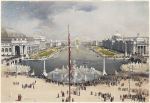
Chicago World’s Fair, 1893
At the time, he was a thirty-one year old history professor from the University of Wisconsin, Madison, but he would go on through John Hopkins University and finally Harvard, having such an eminent career as an historian that his ideas are still discussed and debated today. However, back in 1893, as he gave his discourse to the American Historical Association, down the road Buffalo Bill’s Wild West and Congress of Rough Riders of the World was playing to packed audiences. The U.S. Census Bureau had declared the frontier “closed” in 1890 using their code of density of population. Here were two men representing that frontier in two very different ways. Turner’s idea of the frontier was empty land awaiting occupation in a relatively peaceful manner; it was also a moving line that had started in what we now consider the east and had slowly made its way to the Pacific. It was won with farming tools, such as the plow. Buffalo Bill represented the frontier as a constant battle to wrest lands from the hands of savage indigenous peoples with rifle and knife. In other words, Turner saw the frontier in terms of a defeat of Mother Nature; William Cody saw the frontier as a defeat of Native Americans. What they had in common, however, was that they both saw the frontier as the point where wilderness met civilization, and they both viewed America’s history in terms of the colonization of the ‘West’.
Turner wrote, “The United States lies like a huge page in the history of society” (pg. 23). His history of society went like this: “The buffalo trail became the Indian trail, and this…the trader’s “trace;” the trails widened into roads, and the roads into turnpikes, and these in turn were transformed into railroads…The trading posts…were on the sites of Indian villages…and these…have grown into…cities…” (pg. 25)  Buffalo Bill, on the other hand, saw this history as Indian hostility and white retaliation, neatly turning the vanquishers into victims. It’s interesting to note that his show included, at various times, Sitting Bull and other Sioux who had helped defeat Custer and who would later return to the Dakotas during the Ghost Dance troubles to fight once more. Similarly, Cody would serve as scout for the army during this period.
Buffalo Bill, on the other hand, saw this history as Indian hostility and white retaliation, neatly turning the vanquishers into victims. It’s interesting to note that his show included, at various times, Sitting Bull and other Sioux who had helped defeat Custer and who would later return to the Dakotas during the Ghost Dance troubles to fight once more. Similarly, Cody would serve as scout for the army during this period.
So, is America defined, then, by this one area of the country we call ‘The West’ and, if so, what constitutes that definition? For starters, there had to be an amount of independence in a people heading to settle an unknown wilderness; no longer was there the subordination of a lower, peasant class: they would be landowners. This, in turn, would raise not only a spirit of independence and self-reliance from their ability to manage the range and farmlands now at their disposal, but also a social interdependence from overcoming the obstacles of an arid landscape. The farmer, cowboy, sheepherder would become dependent on the inventor, the irrigator, and the engineer. In turn, according to Turner, a capitalist elite would arise. One has to keep in mind that the water empire is a purely western phenomenon; one-tenth of the world’s total of irrigated acres lie in the seventeen western states between the one-hundredth meridian and the Pacific, so it could certainly be considered a uniquely American venture. Finally, there is the West’s interaction with a federal government, possibly at times tinged with resentment yet still necessitating a give-and-take relationship. It was the government who instituted the Homestead Act, the Desert Land Act and so on, opening the frontier, while today ranchers and farmers must deal with such bodies as the Bureau of Land Management, not always happily. The federal government owns between .03% and 84.5% of land in all states, with the eleven westernmost states varying from 36.6% in CO to that 84.5% in NV.
Turner’s theory, of course, completely disregards a large swathe of what we consider American. It ignores Native Americans, women, and African Americans completely, as one might expect from a dissertation written in 1893. It disregards the culture, already existing at the time, of Hispanic peoples resident predominantly in the Southwest through to California. Miners of every ilk are neglected. Basically, it is an ethnocentric and bigoted view by today’s gauge. No mention is made of the traditions, cuisine, even native costume brought by the many and varied peoples who came across to populate the uninhabited frontier and thereby imparted such to our culture. Yet it remains that the frontier and the West loom large in our nation’s iconography. We must, therefore, be defined by it. And yet I must also ask, if we are defined by the West, then are westerners more ‘American’ than those of us descended from the immigrants who stopped on the east coast? Or are these traits common to us all?
Whether it is Larry McMurtry depicting the Old West or Kent Haruf depicting the New West, the American comes across as persistent, self-reliant, resilient, and indomitable—traits applicable to all Americans, one hopes, and a good mix of what both Turner and Cody saw in the frontier.
Does The Frontier Experience Make America Exceptional?, Etulain, Richard W., Ed., Bedford/St. Martin’s, New York, 1999 Quotes are taken from this edition.
Photo of Frederick Jackson Turner & World’s Fair poster, public domain. Photo of Buffalo Bill Cody taken from my own edition of Story of the Wild West and Camp-Fire Chats, Cody, W. F., Historical Publishing Company, Philadelphia, 1888


November 30, 2015
THE GIFT OF CHRISTMAS
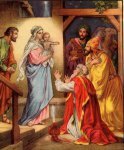 Over two thousand years ago, when three kings—wise men all—crossed the desert bearing gold, frankincense and myrrh to The Babe in the manger, little did they know what sort of tradition they were starting. Had they had foresight, telepathy or any kind of ability to see into the future, they might have thought better of bringing gifts to the Child as an expression of adoration. Nowadays, the expectations that Christmas brings, the commercialism, and the downright need for some sort of reciprocity amongst the gift-givers, has caused us all to lose sight of what is the real meaning behind exchanging gifts.
Over two thousand years ago, when three kings—wise men all—crossed the desert bearing gold, frankincense and myrrh to The Babe in the manger, little did they know what sort of tradition they were starting. Had they had foresight, telepathy or any kind of ability to see into the future, they might have thought better of bringing gifts to the Child as an expression of adoration. Nowadays, the expectations that Christmas brings, the commercialism, and the downright need for some sort of reciprocity amongst the gift-givers, has caused us all to lose sight of what is the real meaning behind exchanging gifts.
So what really constitutes a gift? How many times have you said something akin to, ‘Well, that was a gift!’ related to, not a physical present, but something that happened, something spontaneous or natural, spiritual even. Or perhaps as a child you wanted something so badly, you thought your little heart would burst but knew it was beyond the realms of possibility, and yet… ‘Gifts’ take many shapes and sizes, or perhaps no shape at all.
My own very best gift came in 1983. I was living in Wales at the time and expecting a baby in mid-January but, perhaps with too much holiday celebration, I went into labor on Boxing Day, Dec. 26th. Unfortunately, things did not go well and, because it was a holiday and in a small town, most of the staff were not on duty and had to be called in. You can imagine what this did to me having already had five hours of labor. But, without going into the gory details, the story had a happy ending, and my husband and I were blessed with a baby girl in the wee hours of Dec. 27th. Gifts don’t get any better than that!
I asked five of my favorite authors to join me in celebrating this very special time of year. And, of course, considering that we’re all talking about gifts, they’ve each very kindly consented to giving away one of their books or a bag of goodies to one of five lucky people leaving a comment here. Recipients will be notified on or about Dec. 16th. In the meantime, whether you celebrate Christmas, Hanukah, Kwanzaa, Diwali or nothing at all, I wish you much health (a gift!) and happiness (another gift!) for the holiday season and the year to come. At the bottom of this post I’ve also taken the liberty of noting a few web sites where you might decide to give a gift that helps others—a double gift.
of year. And, of course, considering that we’re all talking about gifts, they’ve each very kindly consented to giving away one of their books or a bag of goodies to one of five lucky people leaving a comment here. Recipients will be notified on or about Dec. 16th. In the meantime, whether you celebrate Christmas, Hanukah, Kwanzaa, Diwali or nothing at all, I wish you much health (a gift!) and happiness (another gift!) for the holiday season and the year to come. At the bottom of this post I’ve also taken the liberty of noting a few web sites where you might decide to give a gift that helps others—a double gift.
 Carmen Peone lives on the Colville Confederated Reservation in Northeastern Washington. She writes Young Adult Fiction which include Native American language and culture.
Carmen Peone lives on the Colville Confederated Reservation in Northeastern Washington. She writes Young Adult Fiction which include Native American language and culture.
CHRISTMAS WISH
As I sit by the crackling fire, Dec. 25, 1989 I pray for a healthy baby. Our third baby in five years. I look at baby Jesus in the Nativity scene and smile, feeling like I’ll have another boy. My nerves feel raw from another hard pregnancy filled with toxemia and months of night sickness. Thankfully I wake up and mornings are filled with happy anticipation, but by evening, I wish I could have a surrogate mother.
So I sit early in the morning of Christmas Day and pray for a healthy baby and safe delivery. Then January comes and I find myself in the emergency room, waiting for Heart Flight to come pick me up. No horse and sleigh. No reindeers. Just a whirling metal chariot coming to give me a ride to Spokane, WA. Upon arrival to Sacred Heart Medical Center, doctors inform me I have placenta previa and I’m to be at bed rest. My due date is my birthday, April 15
Somewhere deep inside, I know this baby will arrive earlier than that. And he does. It’s February 7th, ten weeks early and I sit with tears streaming down my face, begging the nurse as they prep me for emergency Caesarian section to save my baby. I pray that God will find favor as he’s in duress and dying in my womb.
I fall asleep as a tear trickles down my face. I wake hours later, asking a nurse if my baby is alive. She smiles and nods. He’s little, but he’s alive. They’re wheeling me into NICU and I see my Christmas wish, a two-pound baby, not in a manger, but safe in an incubator, alive. He may not be the Savior, but he is our saving grace.
Carmen is happy to gift a signed, softcover copy of Heart of Passion, available at: http://carmenpeone.com/books/heart-of-passion/ 
Spupaleena will do nearly anything to make her dream of breeding the finest race horses in Indian Country come true. She and her relay teammates have been racing and winning, but one boy is resolved to see her fail. Spupaleena is passionate about her dreams and goals. Not any human nor circumstance will deter her–not poison, not injuries, and certainly not a pride-filled, vengeful boy. She leans into God for direction and wisdom, but will the hunger to triumph steal the reins? Will Spupaleena find her place in a man’s world and prove everyone wrong? Follow Spupaleena and her friends as they find out in this tale of drive, faith, perseverance, and ultimately, a Heart of Passion.
 Convinced everyone deserves a happy ending, USA Today bestselling author Shanna Hatfield is out to make it happen, one story at a time. Her sweet historical and contemporary romances combine humor and heart-pumping moments with relatable characters.
Convinced everyone deserves a happy ending, USA Today bestselling author Shanna Hatfield is out to make it happen, one story at a time. Her sweet historical and contemporary romances combine humor and heart-pumping moments with relatable characters.
HOLIDAY SURPRISES WRAPPED IN LOVE
It is such a pleasure to be a guest here today, sharing holiday memories and slipping into a state of nostalgia.
When I was growing up, our house was often the place the extended family gathered for Christmas. Because both my parents came from big families, the two sides of the family alternated years.
The Christmas I was eight, Dad’s side of the family descended on our home bearing gifts, holiday cheer, and enough food to feed a small army.
My grandparents came Christmas Eve to spend the night. Overjoyed to have them there, it did strike me as odd since they’d never stayed before (and that turned out to be the only time they did stay with us for Christmas).
I remember awakening that morning to the most wonderful surprises beneath the tree. Grandpa had made me a dollhouse and Grandma furnished it. She’d even gone so far as to put in wallpaper and little lace curtains. Grandpa also made a cradle for the new baby doll that Santa brought and Grandma made a little quilt along with some clothes.
I still have the dollhouse and the cradle. The wonderful memories of sharing that splendid Christmas morning with my grandparents, of feeling so special and loved, are something I’ll always treasure.
Shanna is gifting a digital copy of The Christmas Cowboy (Rodeo Romance, Book 1) available at http://shannahatfield.com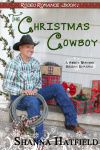
Among the top saddle bronc riders in the rodeo circuit, easy-going Tate Morgan can handle the toughest horse out there, but trying to handle the beautiful Kenzie Beckett is a completely different story.
 Susan Horsnell grew up in Sydney but now lives in sunny Queensland where she spends her days walking her dogs, reading, writing and renovating her home. Married for almost 41 years, she and her husband also enjoy a great deal of travel.
Susan Horsnell grew up in Sydney but now lives in sunny Queensland where she spends her days walking her dogs, reading, writing and renovating her home. Married for almost 41 years, she and her husband also enjoy a great deal of travel.
BEST CHRISTMAS PRESENT
I live in Australia and grew up in Sydney, NSW. We call it the Premier State. My dad was a hard working Painter and Interior Decorator. He worked long hours, often 6 days a week. We didn’t get to see him a lot and for me, the eldest of 5 children who was a daddy’s girl, it was hard.
At Christmas time we were showered with gifts but the best gift for me came on Boxing Day. Dad would pack up our Holden Station Wagon with tent, beds, cooking implements etc etc, late on Christmas Day. At 2am on Boxing day, we would be woken and told to get ready. It was time for our annual holiday.
Our holiday was always on the beach 8 hours north of Sydney. The car packed to the rafters, 4 kids in the back seat (the fifth came 15 years later) and no seatbelts. We would stop for breakfast at a roadhouse where a magpie would invariably tell us to f..k off. It was a stop for the interstate truckers and they had delighted in teaching the Magpie to speak. After many years of complaints, we arrived one year to find Magpie had been relegated to the back of the station where he could no longer offend.
Six hours north of Sydney, travelling over a mountain range, the car would lose a retread. This happened with uncanny regularity year after year. Dad and I would be on the side of the road unpacking the back of the car. Yep, the spare was underneath everything. After changing the tyre while Mum and my brothers and sister remained in the car, Dad and I would attempt to repack the back. Things would never go back in and we would end up nursing a few items for the final two hours.
We would arrive at our destination, pitch the tent and then the rains came. Every year! I look back now and laugh but it really was always a disaster. But the best thing? Every year, at Christmas time, I had my dad for 2 whole weeks. It was the only present I wanted and I always looked forward to it.
He passed away in May of this year, and this Christmas I know my heart will ache for him.
I wish everyone a safe and happy Christmas and New Year.
The winner of Susan’s book may make his/her selection for an autographed paperback at Susan’s website, http://horsnells.wix.com/susan–1 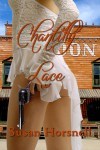
Chantilly Lace
Chantilly ‘Tilly’ Lace O’Malley is a corset wearing, gun toting, whisky drinking saloon owner. She can out-cuss, out-shoot and out-ride any man. The year is 1870 – women like Tilly are rare.
Can Gareth break through her fears to win her heart?
Does he even want to try?
 Award-winning author Paty Jager and her husband raise alfalfa hay in rural eastern Oregon. All her work has Western or Native American elements in them along with hints of humor and engaging characters.
Award-winning author Paty Jager and her husband raise alfalfa hay in rural eastern Oregon. All her work has Western or Native American elements in them along with hints of humor and engaging characters.
CHRISTMAS PEEPER
While I love Christmas more for the giving than the getting, I have to admit I ruined one Christmas for myself when I was thirteen.
From the time I was two until the summer I turned thirteen, my paternal grandparents lived with my family. There were seven of us in an old, three-bedroom, one-bath, farm house. My grandmother was always with us when our parents were at work or away.
My thirteenth summer, my grandparents were moved into a mobile home fifty feet from our house. We (kids) finally had the house to ourselves when we came home from school and during the summer months. This first Christmas with no one to watch our activities, I found the Christmas present stash. I carefully unwrapped all the gifts because my mom liked to use a code on the packages so only she knew who they were for.
By being snoopy, I ruined my Christmas. Nothing was a surprise, it was one of the worst Christmases I’ve had. Half of the fun of Christmas is wondering what you’ll receive for a gift and seeing the happy surprised faces of the people who receive presents from you.
Paty is giving away a digital copy of A Husband for Christmas (Final Novella in the Halsey Homecoming and Halsey Brothers Series) It is available for purchase at http://www.amazon.com/Husband-Christmas-Halsey-Homecoming-ebook/dp/B01608N20K 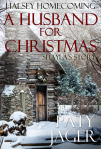
Shayla Halsey wanted to be home for Christmas, but never imagined her travels would include spending the night in a brooding stranger’s cabin. Snowballing events cause her to look inside herself and recognize maybe it wasn’t being home she wanted as much as it was to have a home.
Mace Walker has his life in order and doesn’t want it disrupted again. Yet, when he discovers a woman stranded in the snow, he has to help her—despite her overbearing and reckless fiancé. In a matter of days, Shayla turns his life upside down and forces him to decide if he should leave town or face the consequences.
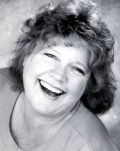 Doris McCraw writes historical fiction under the pen name Angela Raines. She also publishes a photo and haiku Monday through Friday on the fivesevenfivepage on blogspot.com.
Doris McCraw writes historical fiction under the pen name Angela Raines. She also publishes a photo and haiku Monday through Friday on the fivesevenfivepage on blogspot.com.
CHRISTMAS GIFT
Oh the memories of Christmas and the gifts under the tree. Yes, there are some wonderful memories, but the ones that stick with you might not be the joyous ones you believe are important.
When I was around seven or eight, we had gone to my maternal grandmother’s for Christmas Day that year. She and her husband, not my grandfather, lived about twenty minutes away on a farm. The old, one story home in the middle of farmland in Illinois, was typical of such homes. I don’t remember much of the meal, who was there, or even what the day was like weatherwise. What I do remember is getting a beautiful doll. As I unwrapped it, I thought it perfect. Then my grandmother took it back, still in the box it was sold in and put it in another room, saying it was for me when I came to visit.
Now, I know many are thinking that was a cruel thing to do. Yes, it was, but a wonderful lesson was learned that day.
I remember my mother, in no uncertain terms, letting my grandmother know what she thought of her actions. My father was embarrassed and I was hurt. My brother, who is three years younger, didn’t quite get what was going on. The lesson, and a very important one was: People will do cruel things, without realizing what their actions can do. They do not think through beyond their own desires. Later that day, my mother told me, “You can not like what someone has done, but you can still love them.” That is why that particular Christmas has stayed with me all these years. A lesson learned of what love is and can be.
Doris will be giving away an ebook copy from Smashwords of Angel of  Salvation Valley, a paranormal historical western. It is available at http://amzn.com/B016MPKFDI
Salvation Valley, a paranormal historical western. It is available at http://amzn.com/B016MPKFDI
Given a chance at freedom for a crime he didn’t commit, Drew Carson must kill for his pardon. Taken to a lush valley where a beautiful woman lives, Luke, Drew’s “rescuer”, lets him know that the woman is his target–kill her, and he’s a free man. Will Drew trade murder for love?
Some ways to make your gift count:
http://www.nptechforgood.com/2009/11/18/11-holiday-gift-programs-that-benefit-nonprofits-and-make-the-world-a-better-place/ This includes charities that have shops so you can buy a physical gift that benefits others.
http://gift.savethechildren.org/site/c.dvKSIbOSIlJcH/b.6885579/k.BFD5/Home.htm?msource=igxgpgft0513&gclid=Cj0KEQiA96CyBRDk5qOtp5vz8LkBEiQA6wx8MG_AsiEge2lpP03LhQRzCt1YPxcD-r3ZIVEJ4GuGAgQaAk5c8P8HAQ Both presents and donations.
https://www.stjude.org/get-involved/other-ways/st-jude-thanks-and-giving.html?gclid=Cj0KEQiA96CyBRDk5qOtp5vz8LkBEiQA6wx8MOvoTdEa-JiFiEWy2ZdNxpKkD4XTbewO3gcdOR6yCVoaAg9D8P8HAQ&sc_cid=kwp6946&s_kwcid=AL!4519!3!77798603242!b!!g!!donate%20for%20children&ef_id=VkjxZwAAAdgRUpH5:20151115234314:s Donations to St. Jude’s Children’s Hospital can be dedicated to someone with an electronic notification.
https://www.redcross.org/donate/donation?donationProdId=prod10001&flow=oc1&pgver=psearch&scode=RSG00000E017&gclid=Cj0KEQiA96CyBRDk5qOtp5vz8LkBEiQA6wx8MCf1e0fx9sksTFvTFcv6j7X244kHh9ebiIN9EcIE_poaAmuA8P8HAQ&gclsrc=aw.ds&dclid=CM-_z7DOk8kCFRRDDAodZ0YFyg Donations to the Red Cross can be dedicated here as well.
http://beanelf.org/ You read real letters to Santa from needy children and respond. In cooperation with the USPS Operation Santa beginning December 1st.


November 1, 2015
SO YOU THINK WE HAVE FREEDOM OF SPEECH?
A few weeks ago I sought the web page for the NY Public Library, checking to see about opening hours for this magnificent building. What greeted me was a display of various books that had been banned or censored over the years, most of which were well known to me as an avid reader. What I didn’t know was that the last week in September is Banned Books Week, “Celebrating the Freedom to Read.” I wondered whether the freedom to read coexists with the freedom to write?
The Puritans, of course, were masters of telling folks what they could and could not read and write. The first known banned book in America was Thomas Morton’s New English Canaan published in 1637. It encouraged readers to love Native Americans and satirized the Puritans. In the eighteenth century, while America still strained under the yoke of Britain, Defoe’s Moll Flanders and Roxana: the Fortunate Mistress, as well as the perhaps more infamous  Fanny Hill by John Cleland, met the censor’s ax. Fanny Hill bears the dubious distinction of being the last book to be banned throughout the USA. While the dime novels of the nineteenth century may have caused an outrage or two, increased literacy, and hence literary output, seems to have led to an accepted form of censorship. Expurgation and the accompanying bowdlerization of numerous books was acknowledged as protecting public virtue and decency. Even Shakespeare did not elude cuts. Perhaps the most famous of nineteenth century banned books is The Adventures of Huckleberry Finn. Still coming in at number fourteen in 2009, Huck Finn has been repeatedly challenged from all sides of the spectrum.
Fanny Hill by John Cleland, met the censor’s ax. Fanny Hill bears the dubious distinction of being the last book to be banned throughout the USA. While the dime novels of the nineteenth century may have caused an outrage or two, increased literacy, and hence literary output, seems to have led to an accepted form of censorship. Expurgation and the accompanying bowdlerization of numerous books was acknowledged as protecting public virtue and decency. Even Shakespeare did not elude cuts. Perhaps the most famous of nineteenth century banned books is The Adventures of Huckleberry Finn. Still coming in at number fourteen in 2009, Huck Finn has been repeatedly challenged from all sides of the spectrum.  Originally banned as immoral and sacrilegious, not to mention having a lack of respect for adult authority, as time has passed, the baton was dispatched to others, so to speak. In the 1950s, the NAACP began challenging the book as racist because of its portrayal of the slave Jim and the repeated use of racially pejorative terms, namely the N—– word—a conflict that has repeatedly harassed To Kill A Mockingbird as well. During his lifetime, Twain aka Samuel Clemens, simply saw the controversies surrounding his book as excellent fodder for promotion. He knew publicity when he saw it. Harriet Beecher Stowe’s Uncle Tom’s Cabin is occasionally credited with having started the Civil War but, although it may have been difficult to purchase in southern states, it was never officially banned. I’m sure Congress might have liked to ban Helen Hunt Jackson’s A Century of Dishonor as well as Ramona, both of which deal with the treatment of Native Americans, especially by the federal government, but that didn’t happen either.
Originally banned as immoral and sacrilegious, not to mention having a lack of respect for adult authority, as time has passed, the baton was dispatched to others, so to speak. In the 1950s, the NAACP began challenging the book as racist because of its portrayal of the slave Jim and the repeated use of racially pejorative terms, namely the N—– word—a conflict that has repeatedly harassed To Kill A Mockingbird as well. During his lifetime, Twain aka Samuel Clemens, simply saw the controversies surrounding his book as excellent fodder for promotion. He knew publicity when he saw it. Harriet Beecher Stowe’s Uncle Tom’s Cabin is occasionally credited with having started the Civil War but, although it may have been difficult to purchase in southern states, it was never officially banned. I’m sure Congress might have liked to ban Helen Hunt Jackson’s A Century of Dishonor as well as Ramona, both of which deal with the treatment of Native Americans, especially by the federal government, but that didn’t happen either.
However, in the twentieth century, guardians of public morality became rife. Almost everything Theodore Dreiser wrote was either challenged or banned: Sister Carrie, Genius, and An American Tragedy were all held in check by the New York Society for the Suppression of Vice, The Western Society for the Prevention of Vice, and the Boston District Attorney. But it was James Joyce’s
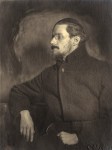
James Joyce
Ulysses, considered by many one of the great masterpieces of modern literature, that really brought up a host of questions as to what is acceptable as freedom of speech and what is not: what has literary merit and what is pornographic? It is a question that bears heavily on free speech, under the jurisdiction of individual states, the federal government only being able to intervene when items are passed between states. The federal government passed an obscenity law in 1873 when the Supreme Court decided that pornography/obscenity was not protected by the First Amendment, yet this still leaves the question open as to what is obscene. The toing and froing over Ulysses took some fifteen years internationally to finally be settled in a NY court of law when it was decided that Joyce’s purpose, despite several sexually explicit scenes, was not pornographic. I can only wonder if E.L. James can truly stand up to such a test. Oh, but I forget: today we have ‘erotic’ literature…
 The other famous court case of the twentieth century was, of course, Lady Chatterly’s Lover. I can well remember the girlish giggles accompanying “discussion” of who had a copy of the book and where we might gather to read passages away from the prying eyes of teachers and parents. Chatterly and Tropic of Cancer, of course. Chatterly had been banned for both its coarse language and explicit scenes of a sexual nature, but in 1959 the ban of this, along with Fanny Hill and Tropic of Cancer, was overturned when the court found it had literary merit. As an aside, let me say that the case was then taken up in the UK the following year, where the judge asked the famous question, “would you want your wife and servants to read this book?” After three hours of deliberation in Her Majesty’s Court, the answer was, “yes.”
The other famous court case of the twentieth century was, of course, Lady Chatterly’s Lover. I can well remember the girlish giggles accompanying “discussion” of who had a copy of the book and where we might gather to read passages away from the prying eyes of teachers and parents. Chatterly and Tropic of Cancer, of course. Chatterly had been banned for both its coarse language and explicit scenes of a sexual nature, but in 1959 the ban of this, along with Fanny Hill and Tropic of Cancer, was overturned when the court found it had literary merit. As an aside, let me say that the case was then taken up in the UK the following year, where the judge asked the famous question, “would you want your wife and servants to read this book?” After three hours of deliberation in Her Majesty’s Court, the answer was, “yes.”
Nowadays, the predominant challenge to books is that they are unsuitable for their age group, having too much violence, too much sex for their age group, containing controversial issues, offensive language, promoting homosexuality, containing drugs/alcohol/smoking/gambling, being socially offensive, containing nudity, and just about any other ‘vice’ you can think of. Heading the list this year was The Absolutely True Diary of a Part-Time Indian, by Sherman Alexie, which work contains “cultural insensitivity” and “depictions of bullying.” The 2009 list, which is the last year for which I can find a full top 100, contains some titles with which most of us are familiar: the Harry Potter series, Of Mice and Men, I Know Why the Caged Bird Sings, The Color Purple, Catcher in the Rye, To Kill A Mockingbird, Snow Falling on Cedars, One Flew Over the Cuckoo’s Nest, The Kite Runner and, yes, Huck Finn is still there. Yet looking at the current list, most of the challenges are by parents who deem certain books as not appropriate for the age for which they were intended. And Tango Makes Three, a true story about same-sex penguins who were given an egg to raise after building a nest together and trying to raise a ‘rock’, has been challenged numerous times as promoting homosexuality. I wonder if the author ever thought twice about not writing this incredible story?
So I go back to my original question: is freedom of speech, and the freedom to read, the same as the freedom to write? With laws defining “hate crimes” as well as obscenity/pornography, are authors free to write as they wish? Are we bound by decency? If we write historical novels, do we think twice about using the N—– word or other racial slurs common to the time period we are depicting? Do we dampen down our scenes of an intimate nature or avoid them altogether simply because we are afraid of parental/friend/spouse/church condemnation? And while my magnificent NY Public Library most likely does not wish to purchase my western historical romances on grounds that they are irrelevant for their reading audiences, how does this decision not to purchase equate with banning books via not purchasing them for the libraries.
Let me know what you think.
All photos public domain
For further information regarding this topic, the following sites are helpful:
http://eduscapes.com/bookhistory/culturalicon/5.htm
http://libraryschool.libguidescms.com/content.php?pid=587594&sid=4857022
http://irishamerica.com/2008/10/the-battle-over-ulysses/
https://en.wikipedia.org/wiki/United_States_v._One_Book_Called_Ulysses
https://en.wikipedia.org/wiki/R_v_Penguin_Books_Ltd
http://www.ala.org/bbooks/top-100-bannedchallenged-books-2000-2009
https://en.wikipedia.org/wiki/United_States_obscenity_law


October 3, 2015
TWO VIEWS ON THE OREGON TRAIL
When I was in school, Francis Parkman’s The Oregon Trail was on my reading list. At the age of thirteen, the formal writing and the lengthy, detailed descriptions of a time, scenery and people who did not in the least interest me, turned me towards another choice of book. So here I am, some fifty years later, with other interests, more tolerance, and certainly a more receptive mind.
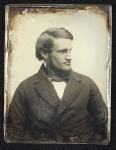
Francis Parkman
Francis Parkman was born into an aristocratic Boston family, son of a well-connected and wealthy Unitarian minister. Plagued by illness most of his childhood, he was often sent into the countryside in an attempt to make him more robust. This, combined with his own enjoyment of James Fenimore Cooper’s novels, seems to have had a lasting effect on the young man whose walks in the woods always entailed carrying a rifle, just as his hero, Hawkeye, did. At Harvard, his interest in Native Americans became evident, and his desire to write histories of the United States (as well as a love of horticulture) took root. Taking time off from college to do a Grand Tour of Europe in order to recover from one bout of his neurological illness, he visited George Catlin’s Indian Gallery in London. This may have been the final push to form plans to travel west. In May, 1846, he finally set out for Independence, MO, with his equally well-heeled cousin, Quincy Adams Shaw. The duo went on to Fort Laramie where, under the sponsorship of the American Fur Company, they were outfitted and prepared for their journey to live with the Oglalla Sioux. Parkman even dressed for the part of a westerner, kitting himself out with buckskins sewn by the Oglalla women at the fort. Years later, he still possessed the outfit when Frederic Remington prepared the illustrations for the deluxe 1892 edition of Oregon Trail.
As anyone who has read The Oregon Trail will know, Parkman pushed himself through many bouts of illness, dosing himself with opium to plod on. In the end, he lived with the Oglalla for three weeks, taking copious notes that eventually formed the book. Parkman would return to Boston where he wrote numerous histories of the United States as well as becoming a professor of horticulture at Harvard, and a founder member of the Archaeological Institute of America.
The Oregon Trail was to have a great influence on the minds and hearts of

Emigrants on the Oregon Trail
Americans. Consider that it still appeared as recommended reading for my school in 1964, and that editions are readily available today. And how many writers of western material or television scriptwriters have taken Parkman’s word and descriptions to heart?
So what is so captivating about The Oregon Trail that it has lasted this long? Parkman was very much a product of his class and times. For someone who was so intent on living with the Native Americans, he is singularly unsympathetic to their plight or their lives, repeatedly referring to them as “mongrels.” Yet while the modern reader may be rightfully appalled at these and other appellations, there is a certain fascination in how prescient Parkman’s writing is: on pg. 90 he describes a wagon train rolling past a native village: “a long train of emigrants with their heavy wagons was crossing the creek, and dragging on in slow procession by the encampment of people whom they and their descendants, in the space of a century, are to sweep from the face of the earth,” and later “…the buffalo will dwindle away, and the large wandering communities who depend on them for support must be broken and scattered. The Indians will soon be abased by whiskey and overawed by military posts…” (pg. 190) Parkman saw this as the natural march of progress much as missionaries see bringing Christianity to indigenous inhabitants a step toward civilization.
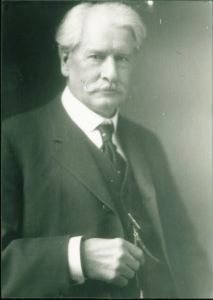
Julius Birge
Some twenty years after Parkman’s journey, Julius Birge left his Wisconsin home to take virtually the same trip. He, too, kept notes, and forty-five years later, in 1912, these would be the basis for The Awakening of the Desert. Also descended from an old New England family, Birge, while not as formally educated as Parkman, was still incredibly well-read and had also suffered illness. One of the reasons he took the trip, which was to ostensibly deliver goods to a Mormon settlement, was to recover from a bout of typhoid. But Birge had grown up in rural Wisconsin amid Pottawattamies and Winnebagos; indeed, he was reputedly the first child ever born to non-native parents in Whitewater, WI. Because of this, Birge’s interests are totally different from Parkman’s, and, perhaps, also because of this, his judgments are gentler. However, both men dealt with Native Americans and both encountered Mormons; both men spent time at the forts along the route and both lighted upon almost identical scenery. They each had treacherous river crossings and knew hardships and thieves. In 1872, in the introduction to the fourth edition of The Oregon Trail, Parkman reassessed his view of that march of progress. He wrote, “…we did not dream how Commerce and Gold would breed nations along the Pacific, the disenchanting screech of the locomotive break the spell of weird, mysterious mountains…had we foreseen it, perhaps some perverse regrets might have tempered the ardor of our rejoicing.” Birge also had the benefit of hindsight; in 1912, some forty-five years after his journey, he knew that such an advancement, more than anything, also marked the end of “…the country as God has made it…” and that western migration was “…depraving and demoralizing even the savages.” (pg.56) His view was that, “the cities and states of America have struggled to increase their population by immigration, apparently on the theory that the rate of that increase was to be the measure of growth in the happiness and prosperity of its people. When our national heritage shall have been partitioned among the nations of the earth, and the wild, wooded hillsides shall have been denuded by axe and fire, giving place for farms and cities, then those whose fortune it has been in childhood to roam through the primitive forests or over the yet free and trackless plains, would hardly exchange the memories of those years for a cycle on the streets…” (pg. 56)
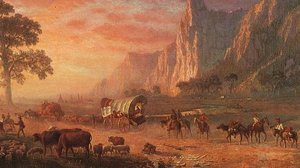
The Oregon Trail by Alfred Bierstadt
I can only wonder why he saw the desert—that great American ‘desert’, the plains—as awakened. It might have been more apposite to say that it had begun its death throes. But how apt his words are today.
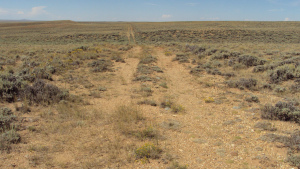
The Oregon Trail at South Pass today
The editions I used for this post are:
Birge, Julius C. and Birge, Barbara B., The Awakening of the Desert: An Adventure-Filled Memoir of the Old West, a CreateSpace 2014 reprint of 1912 edition, Gorham Press, Boston This book is also available at Audible.com For further information, go to http://theawakeningofthedesert.com
Parkman, Francis, The Oregon Trail, Dover Publication, Inc., Mineola, NY, 2002, reprint of 1883 edition, Little, Brown, and Company, Boston.
Parkman, Bierstadt and b & w Oregon Trail photos Public Domain; photos of Julius Birge and South Pass, courtesy of Barbara Birge


September 1, 2015
GOING FOR THE KILL: LORD DUNRAVEN AND THE LAND GRAB OF ESTES PARK
 One of the highlights of my recent cross-country road trip was Estes Park, gateway to Rocky Mountain National Park. And how could it not be a highlight? Here is scenery that both inspires and excites in a corner of Colorado once called the ‘Switzerland of America.’ One of several wide valleys at around 8,000 feet, which include North Park, Middle Park, South Park, and Winter Park,
One of the highlights of my recent cross-country road trip was Estes Park, gateway to Rocky Mountain National Park. And how could it not be a highlight? Here is scenery that both inspires and excites in a corner of Colorado once called the ‘Switzerland of America.’ One of several wide valleys at around 8,000 feet, which include North Park, Middle Park, South Park, and Winter Park, 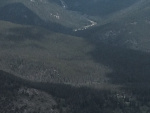 Estes Park itself was renowned for its beauty. But for the long line of British aristocrats that visited the area from the early 1800s, it held a hint of their own landscaped reserves surrounding country estates, yet was a formidable hunting ground, brimming with wildlife they would not encounter back home. No wonder then, given the immense wealth of these visitors, they would want to have it for their own. And one man set out to do just that.
Estes Park itself was renowned for its beauty. But for the long line of British aristocrats that visited the area from the early 1800s, it held a hint of their own landscaped reserves surrounding country estates, yet was a formidable hunting ground, brimming with wildlife they would not encounter back home. No wonder then, given the immense wealth of these visitors, they would want to have it for their own. And one man set out to do just that.
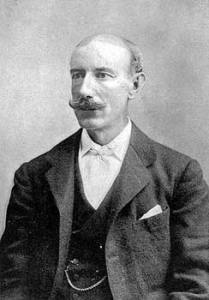 Windham Thomas Wyndham-Quin, 4th Earl of Dunraven and Mount-Earl, an Anglo-Irish peer, first viewed the Rockies in 1869, aged twenty-eight and on his honeymoon. He had gone to Oxford and served in the Queen’s Life Guards. Best known for being a journalist, writing articles on travel and hunting, he was generally considered an enlightened and rather progressive man for his background, and mixed socially with writers, actors and musicians. His boyhood had been spent reading the western novels of Mayne Reid and Fennimore Cooper so that, despite having a young bride in tow, he now aimed to travel west and hunt. Circumstances conspired against him that year, however, and his party reached only as far as Denver. The dramatic backdrop to this burgeoning town was enough to enthrall him. In the next sixteen years, Dunraven was to travel annually to the west, sometimes more than once a year. After all, Denver was ‘only’ seventeen days from Liverpool.
Windham Thomas Wyndham-Quin, 4th Earl of Dunraven and Mount-Earl, an Anglo-Irish peer, first viewed the Rockies in 1869, aged twenty-eight and on his honeymoon. He had gone to Oxford and served in the Queen’s Life Guards. Best known for being a journalist, writing articles on travel and hunting, he was generally considered an enlightened and rather progressive man for his background, and mixed socially with writers, actors and musicians. His boyhood had been spent reading the western novels of Mayne Reid and Fennimore Cooper so that, despite having a young bride in tow, he now aimed to travel west and hunt. Circumstances conspired against him that year, however, and his party reached only as far as Denver. The dramatic backdrop to this burgeoning town was enough to enthrall him. In the next sixteen years, Dunraven was to travel annually to the west, sometimes more than once a year. After all, Denver was ‘only’ seventeen days from Liverpool.
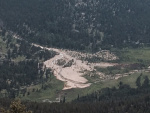 Estes Park had been home to Arapaho and Ute and occasional Apaches. Trappers had passed through, and Missourian Joel Estes came in 1859 to try his hand at ranching there. Griff Evans arrived in 1867 and built cabins to accommodate tourists and lead hunting trips. In 1872, Dunraven finally set eyes on the area for the first time. He had inherited title just a year earlier, and now commanded his family’s extensive fortune, including banks, railroads, shipping and coal, as well as four mansions scattered throughout the British Isles. Having hunted throughout the west on visits over the last three years—including one hunt led by William Cody and his pal, Texas Jack— Dunraven now stayed at one of Evans’ cabins for three weeks and subsequently set his heart on having the park for his private hunting ground. The earl had caught ‘prairie fever’ as Mayne Reid had called it.
Estes Park had been home to Arapaho and Ute and occasional Apaches. Trappers had passed through, and Missourian Joel Estes came in 1859 to try his hand at ranching there. Griff Evans arrived in 1867 and built cabins to accommodate tourists and lead hunting trips. In 1872, Dunraven finally set eyes on the area for the first time. He had inherited title just a year earlier, and now commanded his family’s extensive fortune, including banks, railroads, shipping and coal, as well as four mansions scattered throughout the British Isles. Having hunted throughout the west on visits over the last three years—including one hunt led by William Cody and his pal, Texas Jack— Dunraven now stayed at one of Evans’ cabins for three weeks and subsequently set his heart on having the park for his private hunting ground. The earl had caught ‘prairie fever’ as Mayne Reid had called it.
Why Dunraven favored Estes Park came down to several details, as varied as the beautiful sunsets, the dry air, and the fact nearby Denver was a station for no less than five railroad lines. He loved the area so much that he paid Albert Bierstadt $15,000 for a painting of Estes Park, the first of many he would take home to remind him of his place in the west. The way Dunraven set about obtaining ownership to six thousand acres was a modus operandi that would be employed by numerous ranchers throughout the west in the coming years. Exercising his vast resources, he had his agents bribe various American citizens to make use of both the Pre-emption Act and Homestead Act to either buy or prove up 160 acres each. By choosing the sites wisely, Dunraven enclosed more acreage without access to water. Thirty-one claims were filed for his use.
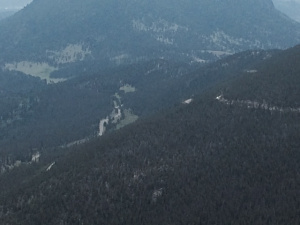 But such a land grab could not go unnoticed. Squatters moved in, and a grand jury was set to investigate his claims. While none of this came to anything, and Dunraven kept his land titles, the harassment showed him the writing on the wall. He had the roads improved and built a hotel as well as a sawmill. Back home in Britain, he was increasingly involved in politics, and would later serve in Her Majesty’s government under Lord Salisbury, as well as in the Senate of the Irish Free State. The Earl made his last visit to Estes Park in 1882, but it was not until 1908 that he sold his land to F.O. Stanley and B. D. Sanborn. Stanley, of course, built the now-historic Stanley Hotel. Rocky Mountain National Park was signed into being in 1915.
But such a land grab could not go unnoticed. Squatters moved in, and a grand jury was set to investigate his claims. While none of this came to anything, and Dunraven kept his land titles, the harassment showed him the writing on the wall. He had the roads improved and built a hotel as well as a sawmill. Back home in Britain, he was increasingly involved in politics, and would later serve in Her Majesty’s government under Lord Salisbury, as well as in the Senate of the Irish Free State. The Earl made his last visit to Estes Park in 1882, but it was not until 1908 that he sold his land to F.O. Stanley and B. D. Sanborn. Stanley, of course, built the now-historic Stanley Hotel. Rocky Mountain National Park was signed into being in 1915.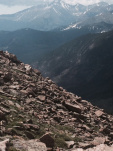
It is a strange anomaly that a man who wrote approvingly about the preservation of Yellowstone as a national park for the enjoyment of the general public, and later would be instrumental in passing the Irish Land Purchase Act of 1903 (permitting tenants to purchase land with favorable terms from their landlords), should want to illegally secure such a large swathe of American countryside. But Dunraven was very much a product of his background, if an enlightened one, and only the first of many Brits who would seek to use the west for their own profit and enjoyment.
My first book, Loveland, deals with this in part. It is to be re-released by Amazon Encore on Sept. 15th.
Photograph of Lord Dunraven in public domain. All other photos Cristal Downing and myself.


August 9, 2015
ROADTRIP 2015 AWARDS!!!!
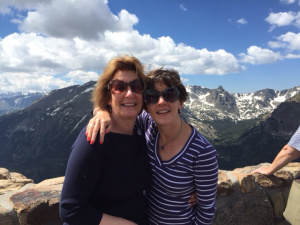 The judges have decided—the votes are in! Having traveled more than 8,000 miles and scoured the country for the very best, here are the 2015 DOWNING ROADTRIP AWARDS…in order of encounter.
The judges have decided—the votes are in! Having traveled more than 8,000 miles and scoured the country for the very best, here are the 2015 DOWNING ROADTRIP AWARDS…in order of encounter.
BEST HISTORIC SITE: Gettysburg National Military Park, http://www.nps.gov/gett/index.htm Gettysburg, PA
Linda Johnston and me
BEST HIKING GUIDE: Linda Johnston, http://www.lindasjohnston.com
BEST COLLEGE REUNION: Laurie Graybeal, Charlotte, NC.
BEST MUSEUM: Museum of the New South, http://www.museumofthenewsouth.org Charlotte, NC
BEST NIGHT OUT: Nashville, TN http://www.nowplayingnashville.com/org/detail/32141/Music_City_Nights_LIVE
BEST DINNER RESTAURANT: Etch, Nashville, TN http://www.etchrestaurant.com
BEST HISTORIC HOUSE: Graceland, Memphis, TN
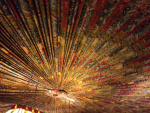
The ceiling in Elvis’ media room
http://www.graceland.com
BEST WEIRD ATTRACTION: The Peabody Ducks, Memphis, TN http://www.peabodymemphis.com/peabody-ducks/
BEST UNEXPECTED GEM: a tie between Augusta, MO, and Manitoulin Is., ON, Canada http://www.augusta-missouri.com & http://www.manitoulin-island.com
MOST GENEROUS LOCAL: Eunice Boevehttp://www.euniceboeve.net
Angela Bates, Eunice Boeve, me and Cristal at Ernestine’s BBQ, Nicodemus
BEST NATIONAL PARK: Nicodemus, Nicodemus, KS

Lake Estes
http://www.nps.gov/nico/index.htm
BEST OUTDOOR ACTIVITY: Walk or run around lake in Estes Park, Rocky Mt. National Park http://www.evrpd.com/marina/lake-estes-trail-a-picnic-areas
BEST DRIVE: Lake Estes, CO to Rock Springs, WY http://www.visitestespark.com & http://www.rswy.net
BEST PLACE TO STRETCH YOUR LEGS AND HAVE LUNCH: Steamboat Springs, CO http://www.creekside-cafe.com & http://www.steamboatchamber.com
BEST TRAVELING COMPANION: Karen Casey Fitzjerrell
Karen Casey Fitzjerrell
http://karencaseyfitzjerrell.com
BEST HOME STAY: Lazy P Ranch, Buffalo, WY http://www.vrbo.com/656153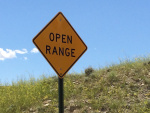
MOST SCENIC DINNER: Buoy’s in Gore Bay, Manitioulin Is., ON, Canada, across from the Queen’s Inn http://www.buoyseatery.com & http://www.thequeensinn.ca
Buoy’s at closing time
BEST LAKE: Lake Huron, Great Lakes, Canada and USA http://www.great-lakes.net/lakes/huron.html
BEST HOTEL: The Omni King Edward, Toronto, ON, Canada http://www.omnihotels.com/hotels/toronto-king-edward?gclid=Cj0KEQjw0ZauBRDOnoGQ2PTb9YoBEiQAQ6m_7LgtH67avVzFAsgyGSjTKKV5LSAw4Kzuvv50zDu-JHsaAjAY8P8HAQ
BEST HIGH SCHOOL REUNION: Gemma Wain, Editor, Toronto, ON, Canada
BEST LUNCH RESTAURANT: Signs, Toronto, ON, Canada http://signsrestaurant.ca
BEST PLACE TO AVOID AT ALL COST: Taylor’s Tea Room, Dundas, ON, Canada http://www.tripadvisor.com/Restaurant_Review-g2645488-d4853835-Reviews-Taylor_s_Tea_Room_Takeaway-Dundas_Hamilton_Ontario.html
BEST AND MOST PRIZED PURCHASES: Two photographs by Janusz Wrobel, studio in Dundas, ON, Canada, and Honorable Mention to hand blown glass by Sam Stang http://www.januszwrobel.com/#1 & http://www.samstang.com
BEST WATERFALL: Niagara, ON, Canada & NYS, USA, with an
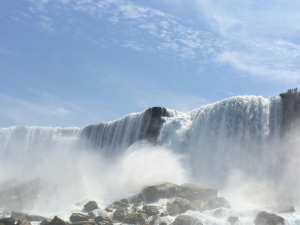
NIagara
Honorable Mention to Munising Falls, Munising, MI, http://www.niagarafallstourism.com & http://www.gowaterfalling.com/waterfalls/munising.shtml
BEST WINE-RELATED ACTIVITIES (OTHER THAN THE NIGHTLY DRINKING OF IT): Canandaigua Wineries Visits http://canandaiguawinetrail.com
Thanks again for traveling with us. If you have any questions or comments related to our awards, they’ll be gratefully received!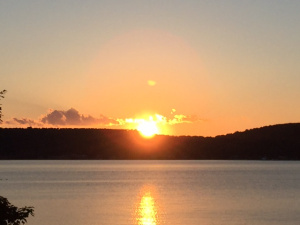


August 5, 2015
HOME SWEET HOME
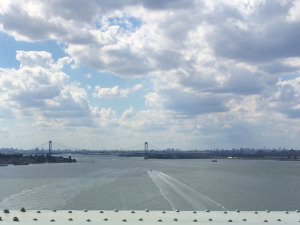 It’s been a long last day, Cristal doing all the final driving from Rhinebeck into NYC, dropping things at her apartment, at my apartment, and then out to my house. She’s dealt with double parking, cutting in, blocking in, speeding and reckless driving on top of all the other traffic woes. But here we are, safe and sound, at home in East Hampton. Our groceries have, happily, been delivered—a perk of living out here—and the first load of wash is in. My own suitcase is still half-unpacked and I haven’t touched the two months of mail waiting for me; the garden is distinctly overgrown, and there were 59 messages of varying importance on the answering machine. But here we are, seven weeks later, having had the experience of our lives and enjoyed (almost) every minute of it.
It’s been a long last day, Cristal doing all the final driving from Rhinebeck into NYC, dropping things at her apartment, at my apartment, and then out to my house. She’s dealt with double parking, cutting in, blocking in, speeding and reckless driving on top of all the other traffic woes. But here we are, safe and sound, at home in East Hampton. Our groceries have, happily, been delivered—a perk of living out here—and the first load of wash is in. My own suitcase is still half-unpacked and I haven’t touched the two months of mail waiting for me; the garden is distinctly overgrown, and there were 59 messages of varying importance on the answering machine. But here we are, seven weeks later, having had the experience of our lives and enjoyed (almost) every minute of it.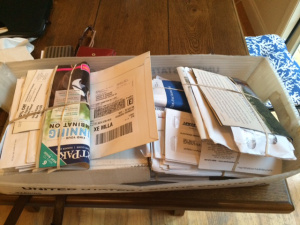
We have a list of some twenty-five awards we’d like to share with you in a day or two, but for now I am signing off. There is no deeply felt summation here; I fear I would get sentimental in the extreme if I tried to do so. But what I would like to say here is that America is every bit as varied and diverse in both its population and its landscape as I hoped it would it be. We are so incredibly lucky in this wide ranging variety, it is impossible to compare our country with anywhere else. Cristal and I both had a fantastic time—there is no other  expression to round it off—and we both would do it again.
expression to round it off—and we both would do it again.
Stay tuned for the Award Ceremony, but for now, thank you for coming along—we’ve enjoyed your company.



